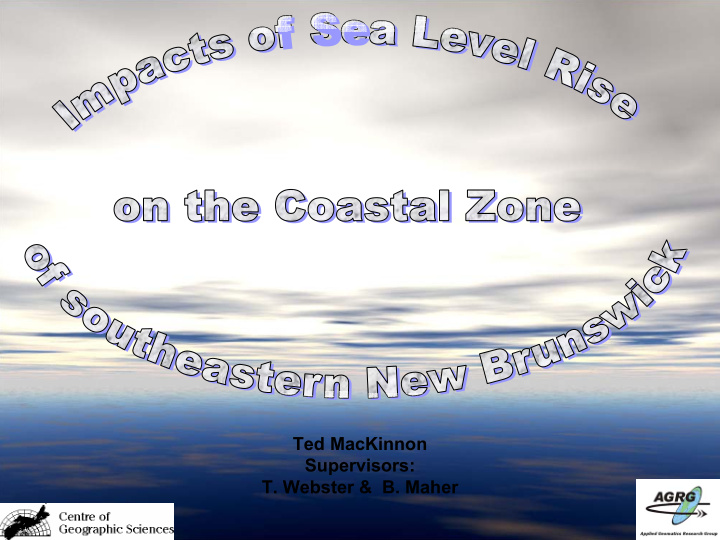



Ted MacKinnon Supervisors: T. Webster & B. Maher
Study Area Study Area
Coastal Sensitivity Coastal Sensitivity to Sea Level Rise to Sea Level Rise (Shaw, 1998)
Impacts of SLR in Impacts of SLR in coastal regions can include: coastal regions can include: • flooding of wetlands and adjacent shores • expanded flooding during severe storms and high tides • increased near-shore wave energy (Erosion) • upward and land-ward migration of beach profiles • saline intrusion into coastal freshwater aquifers • impacts on coastal ecosystems • damage to coastal infrastructure and broad impacts on the coastal economy
Storm Surge and Flooding Storm Surge and Flooding • Storm surges are the meteorological effects on sea level and can be defined at the coast as the difference between the observed water level and the predicted astronomical tide (Environment Canada Website, 2001). • Coastal inundation and extensive damage result when large storm surges occur during times of high tides. • The combined effects of sea-level rise and climate change will lead to higher and more frequent flooding of the existing coastal areas and an increase in erosion of coastal features such as dunes (Webster et al., 2003).
LIDAR LIDAR • can obtain high-resolution data that can be processed to produce an accurate representation of the topography, perfect for predicting areas that are at risk to coastal flooding associated with sea level rise and storm surge events. • The aircraft uses a high precision global positioning system (GPS) and an inertial measurement unit (IMU) to determine the location and measure the attitude so that the ground location of the return laser pulse can be determined.
GPS GPS Aircraft Aircraft (IMU) (IMU) LIDAR LIDAR Points Points (Carter, 2000)
Data Sources Data Sources • RAW LIDAR Data • GPS Validation data • Orthophotos • Topographic data • Flood Data • Satellite imagery • Digital photography • other
• Ground Validation (GPS / Total Station) • LIDAR data assessment • Import Raw Data • Build Grid / DEM • Validate data • Create 3D surface Models • Integrate data and create GIS • Simulate flooding scenarios
Deliverables Deliverables • DEMs • 3D visualizations of the area • Flood risk maps for different flood scenarios • other
Potential Hurdles Potential Hurdles • Terra Remote Sensing • NB double Stereo projection • CAIRIS Files
References • An Airborne Laser Topographic Mapping Study of Eastern Broward County, Florida with Applications to Hurricane Storm Surge Hazard. (n.d.) Retrieved September 19, 2003 from International Hurricane Research Center web site: http://www.ihc.fiu.edu/ihrc/research/broward/browardProject.html • Allen, J., & Birk, R. (2000, August). Flood Mapping Specifications: Technology-centric vs Application-centric. EOM: Earth Observation Magazine, 9(8). Retrieved September 18, 2003 from http://www.eomonline.com/Common/Archives/August00/birk.htm • Barnes, S. (2002). Mapping LIDAR’s future. Geospatial Solutions, 12(3), 18. • Barth, B. C., & Titus, J. G. (1984). Greenhouse Effect and Sea Level Rise – A Challenge for this Generation. New York: Van Nostrand Reinhold Company. • Chrstian, M. (2001). Storm surge floodplain delineation on a LiDAR DEM: A case study of coastal areas of Minas Basin, Kings County, NS. Lawrencetown, NS: Applied Geomatics Research Group, Centre of Geographic Sciences. • Chrstian, M. (2001). Urban applications and flood impact analysis with Lidar data – A case study of Bridgetown Municipality . Lawrencetown, NS: Applied Geomatics Research Group, Centre of Geographic Sciences. • Chrstian, M. and MacKinnon, F.(2001).LIDAR Data Processing. Lawrencetown, NS: Applied Geomatics Research Group, Centre of Geographic Sciences. • Dickie, S. (2001). Storm Surge Inundation Mapping for Charlottetown, Prince Edward Island: Analysing Flood Risk Using High-Resolution Imagery. Lawrencetown, NS: Applied Geomatics Research Group, Centre of Geographic Sciences. • Facts about Canada’s coastline. (2002). Retrieved October 1, 2003 from GSC Atlantic web site: http://gsca.nrcan.gc.ca/coastweb/facts_e.php • Fowler, R. (March, 2002). The Lowdown on LIDAR. EOM: Earth Observation Magazine, 9(8). Retrieved September 18, 2003 from http://www.eomonline.com/Common/Archives/March00/fowler.htm • Lane, P., and Associates (1988). Preliminary study of the Possible Impacts of a One Metre Rise in Sea Level at Charlottetown, Prince Edward Island. Halifax: Climate Change Digest, Atmospheric Environment Service. • MacKinnon, F. (2001). Wetland Application of LIDAR Data: Analysis of Vegetation and Heights in Wetlands. Lawrencetown, NS: Applied Geomatics Research Group, Centre of Geographic Sciences. • Martec Limited (1987). Effects of a One Metre Rise in Sea Level at Saint John, New Brunswick and the Lower Reaches of the Saint John River. Ottawa: Climate Change Digest, Atmospheric Environment Service. • McKenzie, K., and Parlee, K. (2003). The Road Ahead: Adapting to Climate Change in Atlantic Canada. Retrieved September 18, 2003 from http://www.elements.nb.ca/theme/climate03/cciarn/adapting.htm • Sangster, C. (2001). Validating LIDAR – Evaluating LIDAR accuracy using GPS . Lawrencetown, NS: Applied Geomatics Research Group, Centre of Geographic Sciences. • Sapeta, K. (2000). Have you seen the light? LIDAR technology is creating believers. Retrieved September 18, 2003 from http://www.geoplace.com/gw/2000/1000/1000lit.asp • Sea-Level Rise and Climate Change Impacts and Adaptation Needs on Prince Edward Island: Study Results. (2001). Retrieved September 19, 2003 from Environment Canada web site: http://www.ns.ec.gc.ca/press/01-09-06c_back.html • Shaw, J. (2001). Impacts of Sea Level Rise on the Canadian Coast. Retrieved September 18, 2003 from http://climatechange.nrcan.gc.ca/english/View.asp?x-22&oid=28 • Shaw, J., Taylor, R., Solomon, S., Christian, H., and Forbes, D. (1998). Potential impacts of global sea-level rise on Canadian coasts. The Canadian Geographer, 42(4), 365-379. • Shaw, J., Taylor, R., Forbes, D., & Solomon, S. (2001). Sea level rise in Canada. Geological Survey of Canada, Bulletin 548 225-226. • Webster, T., Dickie, S., O’Reilly, C., Forbes, D., Parkes, G., Poole, D., Quinn, R. (2003). Mapping Storm Surge Flood Risk: Using a LIDAR- Derived DEM. USA: Elevation – speacial reprint from Geospatial Solutions. • Webster, T., Dickie, S., O’Reilly, C., Forbes, Thompson, K., D., Parkes, G., (n.d.). Integration of Diverse Datasets and Knowledge to produce High Resolution Elevation Flood Risk Maps for Charlottetown, Prince Edward Island, Canada. Middleton, NS . Applied Geomatics Research Group.
Recommend
More recommend